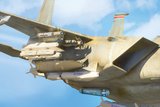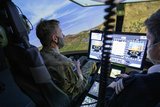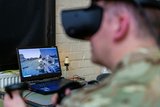Flexibility of Fire Scout Applied to ASW Fight (Studio)
Unmanned Aerial Systems (UAS) could bring unique capabilities to anti-submarine warfare (ASW) search and detection missions, increasing range and endurance, and freeing up manned platforms for other roles.
Indeed, Northrop Grumman recently demonstrated such capabilities for its MQ-8C Fire Scout.
The demonstration in late 2020 saw a surrogate platform – a modified, manned Bell 407 – equipped with sonobuoys, receiver and processor from the UK’s Ultra Electronics. The test was the first time a vertical take-off surrogate UAS was used to conduct a large area multistatic acoustic search.
Dan Redman, Fire Scout maritime mission expansion lead at Northrop Grumman, says the company has for some time been looking at potential new missions for its UAS fleet, against the backdrop of declining budgets and ageing fleets in NATO member states and their allies.
Efforts were focused on the Fire Scout and the MQ-4C Triton, both of which are already in service with the US Navy. The platforms’ manned counterparts – the MH-60R Seahawk and the Boeing P-8 Poseidon – both focus on ASW, ‘so it just seemed natural to us that we would go down that route’.
Redman says Northrop Grumman partnered with ASW specialist Ultra Electronics to jointly develop the capability, with the British company already ‘on a path to reduce the size, weight and power of their equipment… there was a great match between our systems and their technology’.
This partnership culminated in the test off the coast of Southern California in October, during which the companies demonstrated the capacity for an enhanced Fire Scout to carry and deploy “G”-size buoys, which are 16.5 inches long.
Thomas Link, president of Ultra Maritime, said at the time of the original partnership that ‘operating prototype hardware in a high-pressure, real-world environment can be challenging. Our partnership will bring an innovative and leading ASW capability into operation, combining both manned and unmanned ASW systems that will help defend our warfighters and provide increased capability to our forces’.
In the demonstration, the sonobuoys were dropped from the helicopter and the companies conducted the various facets of a typical ASW mission, Redman explains.
This included both passive and active detection, and the multistatic approach, which deploys a mix of specialised active and passive buoys at different locations to generate a more detailed picture.
This latter option is particularly interesting for the Fire Scout, Redman says, as it ‘allows us to match our endurance with a very large field size to be searched’.
The Fire Scout is already qualified for all US Navy, air-capable ships, Redman notes, meaning operators ‘don’t have to start from scratch’ to develop such a UAS ASW capability, which would be costly in both time and money.
The company’s analysis shows that the platform can carry up to 40 G-size sonobuoys, flying for up to 12 hours as far as 100 miles from its ship. Additionally, the platform is organic to the ship, he notes, meaning operators are not required to call up a capability from land.
‘It keeps you safe and pushes that threat bubble very far out,’ Redman says.
Using Fire Scout in ASW search and detection essentially gives it a dual maritime surveillance capability, as it already has a radar integrated onboard. This versatility can free up manned platforms for other missions, Redman notes, while there could also be significant opportunities for manned-unmanned teaming in various configurations of platforms.
‘There’s a cost to having those manned aircraft conduct the initial search phase of an ASW mission,’ Redman says.
‘It takes an awfully long time, and that’s going to increase costs, and it’s going to increase wear and tear on those manned assets.’
Adapting Fire Scout for ASW could save costs on manned platforms, ‘and then use them for the really important missions where they’re needed’.
Fire Scout has already been certified for many ships, Redman emphasises, and could readily qualify for other air-capable platforms in the international market.
‘It’s in the system logistically and it’s well-proven through all the work that’s been done – it’s already flying,’ he says.
‘You don’t have any real hurdles to overcome … all the airworthiness and safety issues that have to be addressed have already been done with a Fire Scout, so you can take advantage of that.’
The companies have completed the prototyping and demonstration phases and now aim to develop a production sonobuoy launcher, likely sometime in the second half of 2022.
In their original announcement, the companies noted that while the US Navy has not yet identified a clear requirement for such a UAS ASW capability, it has shown interest in the development and is monitoring and supporting progress.
Redman says there has also been a strong level of international interest in the project.
‘Our goal is to be ready. If the Navy isn't the first customer, there may be another customer that will be first, but we want to have the technology and we want to be ready to go.’
More from Studio
-
![Combat-proven capabilities: How precision-strike systems are evolving for tomorrow’s battlespace (podcast)]()
Combat-proven capabilities: How precision-strike systems are evolving for tomorrow’s battlespace (podcast)
Combat-tested technology is being reshaped to counter A2/AD threats, reduce reliance on GPS and enable faster, more autonomous targeting in complex environments. In this special podcast, experts explain how the evolving threat landscape is shaping next-generation strike capabilities.
-
![Energy evolution: How laser defence systems are powering the next phase of air defence (podcast)]()
Energy evolution: How laser defence systems are powering the next phase of air defence (podcast)
Laser-based air defence is moving from promise to deployment as global threats evolve. In this special podcast, we explore how high-energy laser systems are reshaping interception strategies.
-
![Intelligence advantage: How real-time GEOINT is reshaping military decision-making (Studio)]()
Intelligence advantage: How real-time GEOINT is reshaping military decision-making (Studio)
In today’s contested operational environment, adaptability is key. The new Geospatial-Intelligence as a Service (GEO IaaS) solution from Fujitsu and MAIAR empowers militaries by enabling intelligence advantage, combining advanced technology with human expertise to deliver actionable insights.
-
![Training Together: Unlocking Educational Excellence through Military and Industry Collaboration (Studio)]()
Training Together: Unlocking Educational Excellence through Military and Industry Collaboration (Studio)
Military training is ultimately about people. At Capita, training programmes are built on close engagement with partners, delivering an educational approach that can adapt to individual needs, cultivate leadership – and drive wider cultural change.
-
![Enhancing Military Training Through Digital Technology (Studio)]()
Enhancing Military Training Through Digital Technology (Studio)
Digital technologies offer huge opportunities for defence training. However, militaries must adopt an agile approach, placing the needs of their organisations and personnel at the centre of their efforts.
-
![Layered Defence: How new technologies are enhancing armoured vehicle survivability and manoeuvrability (Studio)]()
Layered Defence: How new technologies are enhancing armoured vehicle survivability and manoeuvrability (Studio)
As modern threats evolve, armoured fighting vehicles face a new era of challenges, from loitering munitions to kinetic energy projectiles. Advances in active, passive, and reactive protection systems are crucial to ensuring battlefield dominance, freedom of manouver and vehicle survivability.

























